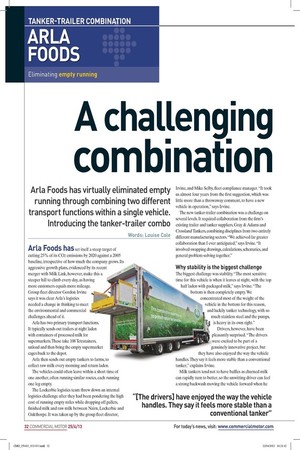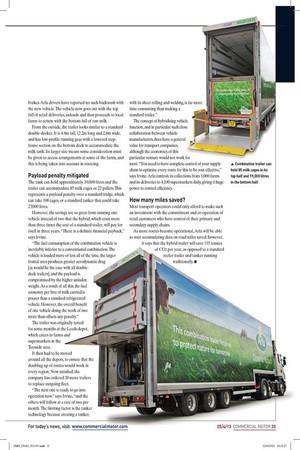A challenging combination Arta Foods has virtually eliminated empty running
Page 23

Page 24

If you've noticed an error in this article please click here to report it so we can fix it.
through combining two different transport functions within a single vehicle. Introducing the tanker-trailer combo Words: Louise Cole Arta Foods has set itself a steep target of cutting 25% of its CO2 emissions by 2020 against a 2005 baseline, irrespective of how much the company grows. Its aggressive growth plans, evidenced by its recent merger with Milk Link, however, make this a steeper hill to climb every day, as having more customers equals more mileage. Group fleet director Gordon Irvine says it was clear Arla's logistics needed a change in thinking to meet the environmental and commercial challenges ahead of it.
Arta has two primary transport functions. It typically sends out trailers at night laden with containers of processed milk for supermarkets. These take 108 Tetratainers, unload and then bring the empty supermarket cages back to the depot.
Arta then sends out empty tankers to farms, to collect raw milk every morning and return laden.
The vehicles could often leave within a short time of one another, often running similar routes, each running one leg empty.
The Lockerbie logistics team threw down an internal logistics challenge after they had been pondering the high cost of running empty miles while dropping off pallets, finished milk and raw milk between Nairn, Lockerbie and Oakthorpe. It was taken up by the group fleet director, Irvine, and Mike Selby, fleet compliance manager. "It took us almost four years from the first suggestion, which was little more than a throwaway comment, to have a new vehicle in operation," says Irvine.
The new tanker-trailer combination was a challenge on several levels. It required collaboration from the firm's existing trailer and tanker suppliers, Gray & Adams and Crossland Tankers, combining disciplines from two entirely different manufacturing sectors. "We achieved far greater collaboration than I ever anticipated," says Irvine. "It involved swapping drawings, calculations, schematics, and general problem-solving together."
Why stability is the biggest challenge The biggest challenge was stability. "The most sensitive time for this vehicle is when it leaves at night, with the top half laden with packaged milk," says Irvine. "The bottom is then completely empty. We concentrated most of the weight of the vehicle in the bottom for this reason, and luckily tanker technology, with so much stainless steel and the pumps, is heavy in its own right."
Drivers, however, have been pleasantly surprised. "The drivers were excited to be part of a genuinely innovative project, but they have also enjoyed the way the vehicle handles. They say it feels more stable than a conventional tanker," explains Irvine.
Milk tankers tend not to have baffles as churned milk can rapidly turn to butter, so the unwitting driver can feel a strong backwash moving the vehicle forward when he brakes. Arta drivers have reported no such backwash with the new vehicle. The vehicle now goes out with the top full of retail deliveries, unloads and then proceeds to local farms to return with the bottom full of raw milk From the outside, the trailer looks similar to a standard double-decker. It is 4.4m tall, 12.2m long and 2.6m wide, and has low-profile running gear with a lowered stepframe section on the bottom deck to accommodate the milk tank. Its larger size means some consideration must be given to access arrangements at some of the farms, and this is being taken into account in routeing.
Payload penalty mitigated The tank can hold approximately 19,000 litres and the trailer can accommodate 85 milk cages or 22 pallets. This represents a payload penalty over a standard fridge, which can take 108 cages, or a standard tanker that could take 27,000 litres.
However, the savings are so great from running one vehicle instead of two that the hybrid, which costs more than three times the cost of a standard trailer, will pay for itself in three years. "There is a definite financial payback," says Irvine.
"The fuel consumption of the combination vehicle is inevitably inferior to a conventional combination. The vehicle is loaded more or less all of the time, the larger frontal area produces greater aerodynamic drag [as would be the case with all doubledeck trailers], and the payload is compromised by the higher unladen weight. As a result of all this, the fuel economy per litre of milk carried is poorer than a standard refrigerated vehicle. However, the overall benefit of one vehicle doing the work of two more than offsets any penalty."
The trailer was originally tested for some months at the Leeds depot, which caters to farms and supermarkets in the Teesside area.
It then had to be moved around all the depots, to ensure that the doubling up of routes would work in every region. Now satisfied, the company has ordered 20 more trailers to replace outgoing fleet.
"The next one is ready to go into operation now," says Irvine, "and the others will follow at a rate of two per month. The limiting factor is the tanker technology because creating a tanker, with its sheet rolling and welding, is far more time-consuming than making a standard trailer."
The concept of hybridising vehicle function, and in particular such close collaboration between vehicle manufacturers, does have a general value for transport companies, although the economics of this particular venture would not work for most. "You need to have complete control of your supply chain to optimise every route for this to be cost-effective," says Irvine. Arta controls its collections from 3,000 farms and its deliveries to 4,100 supermarkets daily, giving it huge power to control efficiency.
How many miles saved?
Most transport operators could only afford to make such an investment with the commitment and co-operation of retail customers who have control of their primary and secondary supply chains.
As more routes become operational, Arta will be able to start accumulating data on road miles saved; however, it says that the hybrid trailer will save 155 tonnes of CO2 per year, as opposed to a standard reefer trailer and tanker running traditionally. •







































